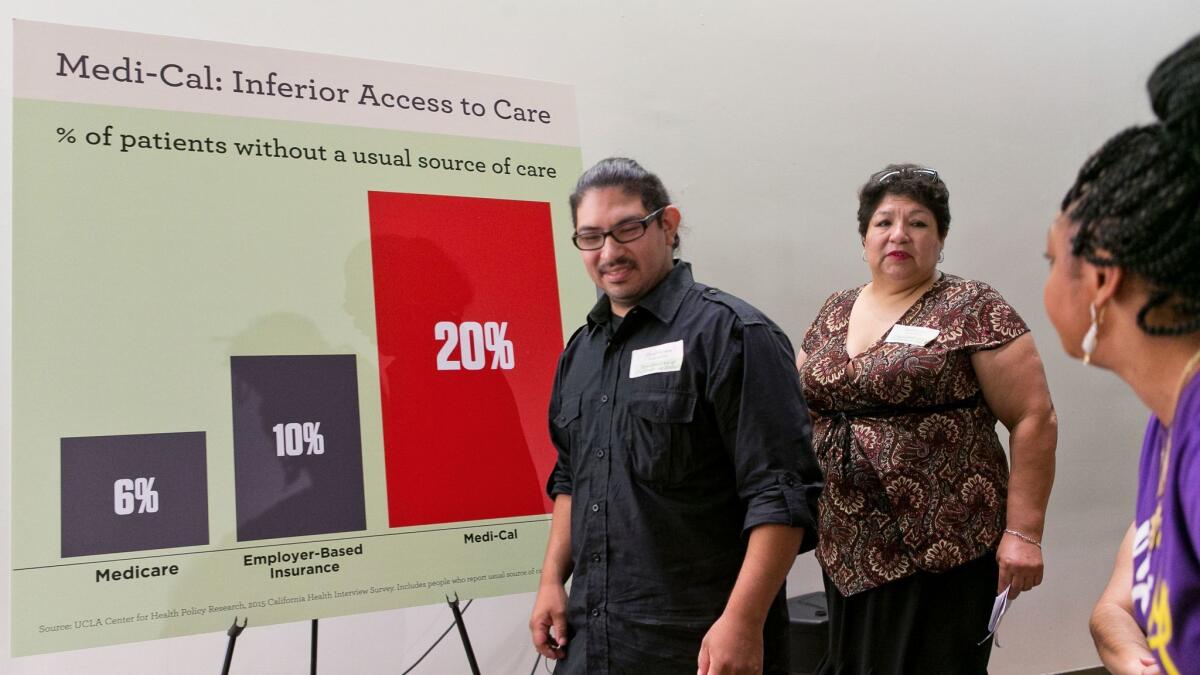Editorial: Does state funding for Medi-Cal discriminate against the Latinos it serves?

Only about half of the non-emergency care doctors in California are willing to treat patients who are on Medi-Cal — the state’s version of Medicaid, the joint federal-state health insurance program for the poor and disabled — because the state pays them too little for their services. Yet the federal government, which sets and enforces Medicaid’s standards for access to care, has consistently given the state’s program permission to continue as-is.
Now, two civil rights organizations are asking a judge to order the state to spend more on the program. In a recently filed lawsuit, the Mexican-American Legal Defense and Educational Fund and the Civil Rights Education and Enforcement Center claim that the state’s underfunding of Medi-Cal discriminates against Latinos in violation of California law. Their clients include half a dozen Medi-Cal enrollees who were denied timely care for agonizing medical problems, largely because they had trouble finding specialists who would accept their insurance.
The implications of the case are huge. Medi-Cal covers 13.5 million people, or about one out of every three Californians, and costs $89 billion a year — about two-thirds of it coming from the federal government. Forcing the state to pay more for medical procedures would be enormously costly, potentially leading lawmakers to cut the number of people eligible for the program, reduce the services it covers, or both.
The MALDEF lawsuit illustrates how the cuts in provider rates have translated into pain for individual Californians.
That’s why Medi-Cal’s budget involves policy trade-offs that should be made by the Legislature, not by litigants. Yet by persistently underfunding key parts of the program, lawmakers and Gov. Jerry Brown have invited the courts to make these decisions for them.
This week a federal appeals court revived a separate challenge to Medi-Cal provider rates by a group of hospitals, which claim a 10%, across-the-board cut in provider fees the state ordered in 2011 violates federal Medicaid standards. Under federal law, Medicaid programs’ fees must attract enough doctors to make care and services available “at least to the extent that such care and services are available to the general population in the geographic area.”
But even before that cut, California was paying healthcare providers less and spending less per patient than most other states’ Medicaid programs. According to MALDEF’s complaint, the state pays Medi-Cal doctors little more than half as much as the federal government pays when the same procedures are performed on seniors covered by Medicare.
The MALDEF lawsuit contends that the state’s handling of Medi-Cal amounts to discrimination against Latino Californians because Medi-Cal’s population is disproportionately Latino; in fact, it argues, the underfunding problem has grown as Latinos have come to dominate the Medi-Cal rolls. The lawsuit also alleges that the state has failed to monitor the program to make sure patients have timely access to care, and that the program’s red tape discourages doctors from participating.
State judges will decide whether Medi-Cal’s funding levels discriminate against Latinos or if it is administered in a way that violates the state’s constitutional guarantees. But the assertion that the program is discriminatory is dubious. Plaintiffs don’t allege that Latinos are treated worse than anyone else on Medi-Cal. Instead, they claim that Latinos aren’t served as well by this safety net program as others are served by employer-sponsored health plans or Medicare — insurance programs that are paid for at least in part by the participants themselves.
No question, it would be great if a safety net program could offer healthcare as extensive as private insurance or Medicare. But that may not be possible or practical, and it can’t reasonably be guaranteed by law. The fiscal pressures on the state force lawmakers to balance competing demands, so increasing Medi-Cal provider fees could require cuts in benefits, a reduction in the number of people eligible for coverage, or sacrifices in other state programs. How to strike that balance is a policy judgment, not a legal one.
For several years the Legislature prioritized expanding eligibility for Medi-Cal over improving access to care for those already in the program. Now, the state is starting to raise provider rates, thanks to an initiative in November (Proposition 56) that raised the tobacco tax sharply and dedicated much of the money to Medi-Cal. Lawmakers — who are led by Latinos in both the Assembly and the Senate — decided to use up to $800 million this fiscal year to raise provider rates an estimated 2.5%.
This page has long urged the Legislature to make raising provider rates its top Medi-Cal priority and to pay more attention to problems with access to care. The MALDEF lawsuit illustrates how the cuts in provider rates have translated into pain for individual Californians. With the infusion of tobacco tax dollars, however, lawmakers have started to raise those rates and make care more available. Lawmakers need to continue that process, or else the courts will do it for them.
Follow the Opinion section on Twitter @latimesopinionand Facebook
More to Read
A cure for the common opinion
Get thought-provoking perspectives with our weekly newsletter.
You may occasionally receive promotional content from the Los Angeles Times.










